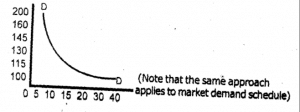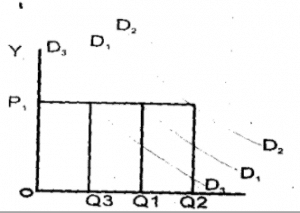By demand, we mean the amount or quantity of commodity service that consumers are willing and ready to purchase at a given price and at a particular period of time. It should be borne in mind that demand differs from “want” in that the former is usually backed up by the ability and readiness to pay. It is called purchasing power in Economics. There are two types of demand namely Individual demand and Market or Aggregate demand.
By individual demand, we mean the amount or quantity of a product, which a consumer is willing and able to buy at any given price and at a particular period of time. While market or aggregate demand is the total amount of a product which all the consumers in the market are willing and able to purchase at any given period and at a particular time. Market or aggregate demand is the combined demand of all the consumers in the market.
LAW OF DEMAND
This law states that the lower the price of a commodity the greater the quantity of it to be demanded. “Ceteris paribus”
Let us take the individual demand schedule for illustration. Assuming the price of Vitalo tea (a tin) is N100.00 for low- income earners there is the tendency to buy more than when a tin costs about N200.00.
The table below shows the illustration graphically. Individual Demand Schedule: This is a table that shows the quantity of goods demanded at various prices.
| Price per tin | Quantity demanded per week |
| 100 | 40 |
| 115 | 30 |
| 130 | 25 |
| 145 | 20 |
| 160 | 10 |
| 200 | 5 |
FACTORS AFFECTING CHANGES IN DEMAND
- The price of goods
- The price of other relative goods
- The income of the consumers
- Changes in taste and fashion
- Expectation of future changes in price
- Changes in population or number of consumers.
- Effects of advertisements, religion and culture.
- Government policy
- Easy payments of goods by the consumer.
CHANGE IN QUANTITY DEMANDED:
This involves the movement of change in demand along the same demand curve. A fall in price brings about an increase in the quantity demanded and vice-versa. The only factor causing change in quantity demanded is the price of the commodity being demanded. When price of goods increases, the quantity demanded will fall, and when the price of goods decreases, quantity demanded will rise.
From the above graph, we understand that at each of the prices, P1, P2 and P3, the quantities Q1, Q2 and Q3 are demanded respectively. Other factors that can influence the quantities of goods demanded apart from price are:
- Expectation of future changes in price.
- Changes in consumers’ income Changes in population.
- Tastes preferences of consumers
- Changes in the tax structure
- Changes in the price of other goods.
EXPANSION OR CONTRACTION OF DEMAND
By expansion or contraction of demand, we mean the movement or shift in the locus of demand curve. This implies that at the old price, different quantity was demanded showing that there is no change in price.
The above graph shows that the demand curve moves from Dl to D2. At the price OP1, the quantity OQ1, was demanded. And when there was a change in demand, there was a consequent movement in the demand curve from Dl to D2 and at the price OP1, the quantity demanded increases to 0Q2. While a shift from Dl to D3 shows a decrease or contraction of demand.


